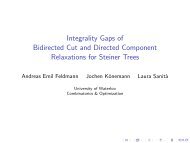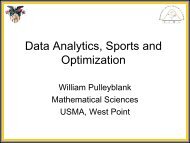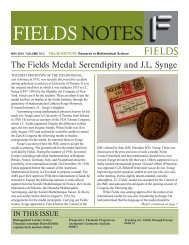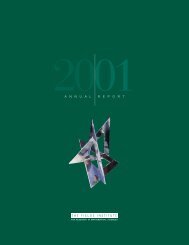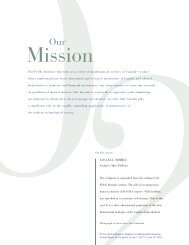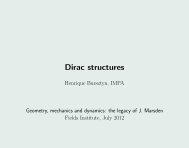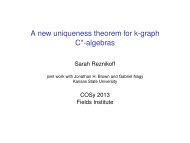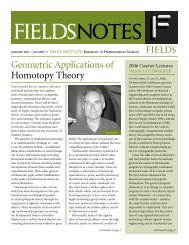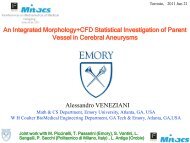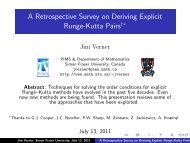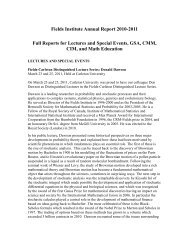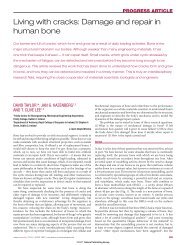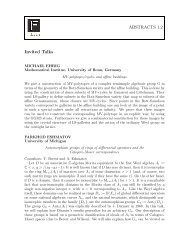Annual Report 2005 - Fields Institute - University of Toronto
Annual Report 2005 - Fields Institute - University of Toronto
Annual Report 2005 - Fields Institute - University of Toronto
You also want an ePaper? Increase the reach of your titles
YUMPU automatically turns print PDFs into web optimized ePapers that Google loves.
Other issues center around various apparent paradoxes<br />
related to black hole entropy, despite the significant progress<br />
mentioned above, and around the description <strong>of</strong> the<br />
process <strong>of</strong> inflation, through which our universe expanded<br />
rapidly from a tiny size to become large and smooth, while<br />
generating the tiny perturbations which eventually grew<br />
into the galaxies and clusters <strong>of</strong> galaxies that we see today.<br />
The goal <strong>of</strong> the “Workshop on Gravitational Aspects <strong>of</strong><br />
String Theory” was to further explore the implications <strong>of</strong><br />
the connections described above, and to chip away at the<br />
fundamental questions which yet remain to be answered.<br />
Organized by Per Kraus, Don Marolf and Amanda Peet as<br />
a part <strong>of</strong> the thematic program on the Geometry <strong>of</strong> String<br />
Theory jointly sponsored by the <strong>Fields</strong> <strong>Institute</strong> and Perimeter<br />
<strong>Institute</strong> (in Waterloo), the workshop brought together<br />
approximately 75 theoretical physicists from across North<br />
America and Europe for a week <strong>of</strong> seminars and discussion.<br />
Discussion and interaction were a central theme <strong>of</strong> the<br />
workshop: there were no more than four hours <strong>of</strong> talks<br />
each day, and the talks were presented by a variety <strong>of</strong> senior<br />
faculty, junior faculty, postdocs, and students. During the<br />
rest <strong>of</strong> the day the participants were strongly encouraged<br />
to make use <strong>of</strong> the <strong>Fields</strong> <strong>Institute</strong> facilities for numerous<br />
small to medium scale discussions on the above issues.<br />
The result appears to have been a great success, leading one<br />
noted string theorist to state that the meeting was “probably<br />
the best meeting I have been to in a number <strong>of</strong> years.”<br />
As one would expect from the theme, most <strong>of</strong> the talks<br />
addressed issues related to black holes and to cosmological<br />
singularities. Gary Horowitz <strong>of</strong> the <strong>University</strong> <strong>of</strong> California<br />
at Santa Barbara discussed an approach in which a<br />
T h e m a t i c P r o g r a m s<br />
Amanda Peet, Don Marolf and Per Kraus<br />
cosmological singularity is mapped to a certain process in<br />
an ordinary quantum field theory via the AdS/CFT correspondence.<br />
As he explained, the hope is that the singularity<br />
might be more tractable in the new language. Bernard de<br />
Wit <strong>of</strong> Utrecht <strong>University</strong> and Alex Maloney <strong>of</strong> Stanford<br />
<strong>University</strong> described recent progress in using quantum<br />
gravity effects to cloak would-be naked singularities by<br />
event horizons. This leads to black holes whose entropy is<br />
small, but in precise agreement with certain microscopic<br />
computations in string theory, thus extending our microscopic<br />
understanding <strong>of</strong> black holes. Eva Silverstein <strong>of</strong><br />
SLAC described a novel method for removing singularities<br />
by using tachyon condensation to effectively halt the spacetime<br />
evolution before the singularity can form. Another<br />
potential way <strong>of</strong> avoiding singularities in black holes is to<br />
look for new solutions which look like black holes far away,<br />
but in fact deviate close in such a way that there is no event<br />
horizon or singularity. This approach has been actively<br />
investigated in the past few years, and Simon Ross <strong>of</strong> the<br />
<strong>University</strong> <strong>of</strong> Durham described some recent progress.<br />
Another type <strong>of</strong> pathology in gravity is the potential existence<br />
<strong>of</strong> closed timelike curves (“time machines”). Miguel<br />
Costa <strong>of</strong> Porto <strong>University</strong> discussed a mechanism for excising<br />
them from the spacetime using stringy effects.<br />
An interesting development in the past year has been the<br />
discovery <strong>of</strong> new black ring solutions. These are black holes<br />
whose event horizons are not spherical, but instead have a<br />
ring topology. The workshop heard four talks by the pioneers<br />
in this subject: Henriette Elvang and Harvey Reall <strong>of</strong><br />
the <strong>University</strong> <strong>of</strong> California at Santa Barbara, David Mateos<br />
<strong>of</strong> the Perimeter <strong>Institute</strong>, and Roberto Emparan <strong>of</strong> the<br />
<strong>University</strong> <strong>of</strong> Barcelona.<br />
<strong>Fields</strong> <strong>Institute</strong> <strong>2005</strong> ANNUAL REPORT 29



